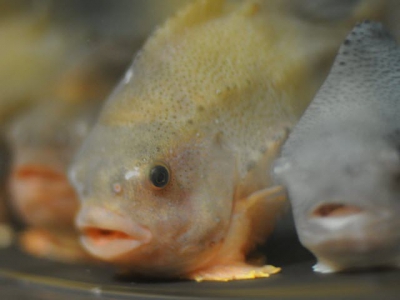Lumpfish threatened by salmon sector

The salmon farming industry must look into ways of only using sterile lumpfish that have been produced from captive broodstock in order to retain the volume and genetic integrity of local stocks, according to a new study.
The report argues that using lumpfish derived from wild-caught stocks could have a number of detrimental consequences
Lumpfish – which are currently largely derived from eggs obtained from wild-caught broodstock – are widely stocked in salmon farms in order to remove parasitic sea lice from salmon. However, despite the many positives of this process – not least for helping to improve salmon welfare and reduce the number of medicinal lice treatments required on the farms – the authors of the study warn that this may be having several undesirable effects on lumpfish populations.
In conducting the research, Benjamin Whittaker, Sofia Consuegra and Carlos Garcia de Leaniz – all from Swansea University’s Centre for Sustainable Aquatic Research – looked into genetic and phenotypic variation across the species' range to estimate the level of genetic and phenotypic differentiation, and determined patterns of gene flow at spatial scales relevant to management. The results, published this week, as Genetic and phenotypic differentiation of lumpfish (Cyclopterus lumpus) across the North Atlantic: implications for conservation and aquaculture, show that there are five genetically distinct groups of the species. These are located in the West Atlantic (USA and Canada), Mid Atlantic (Iceland), East Atlantic (Faroe Islands, Ireland, Scotland, Norway and Denmark), English Channel (England) and Baltic Sea (Sweden).
As well as the different genetic groups, significant phenotypic differences were also found, with Baltic lumpfish growing more slowly, attaining a higher condition factor and maturing at a smaller size than North Atlantic lumpfish. As a result of such variations, the authors argue that lumpfish escaping from salmon farms could jeopardise the genetic integrity of the surrounding wild stocks.

The researchers discovered five genetically distinct lumpfish populations
The authors also noted that estimates of effective population size were consistently low across the North East Atlantic (Iceland, Faroe Islands and Norway), the area where most wild lumpfish are captured – both for their roe, and for the aquaculture industry. And therefore, they argue, greater restrictions should be placed on the capture of lumpfish, and the aquaculture sector should concentrate only fish that have been hatched from farmed lumpfish broodstock.
“Our study suggests that lumpfish translocations should be restricted within genetically homogenous groups to reduce the risk of genetic introgression between native and non-native populations. In this sense, lumpfish from some areas of Norway, and particularly from Iceland, may be ill-suited for deployment in Ireland, Scotland and the Faroe Islands, and vice-versa. Ultimately, closing the breeding cycle of the species in captivity, and producing sterile lumpfish for deployment in salmon farms, must be a research priority for both the conservation of the species and the cleaner fish industry as this will lessen dependency on wild broodstock and reduce the risk of genetic introgression,” the paper concludes.
Related news
 A fresh approach to understanding aquaculture
A fresh approach to understanding aquaculture A new, innovative and interactive approach to generating interest in aquaculture is now publicly available, following the publication of a number of stories
 Yeast-protein use may provide fishmeal alternative for trout feeds
Yeast-protein use may provide fishmeal alternative for trout feeds Use of a yeast-based protein and synthetic amino acids can maintain trout growth when replacing fishmeal, but more work is needed to understand the ingredients
 Super grouper: advances in RAS production in Asia
Super grouper: advances in RAS production in Asia Despite being overfished in China and South East Asia, a suite of advances in sustainable aquaculture of a number of grouper species is bringing benefits